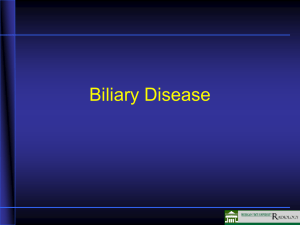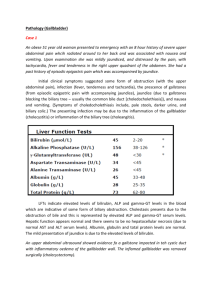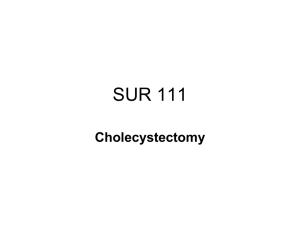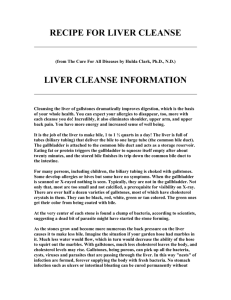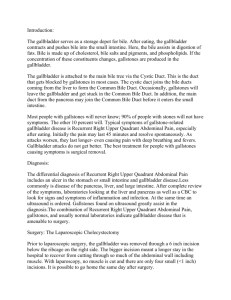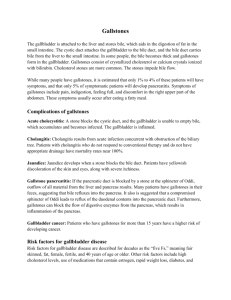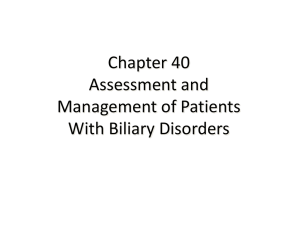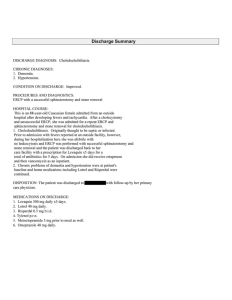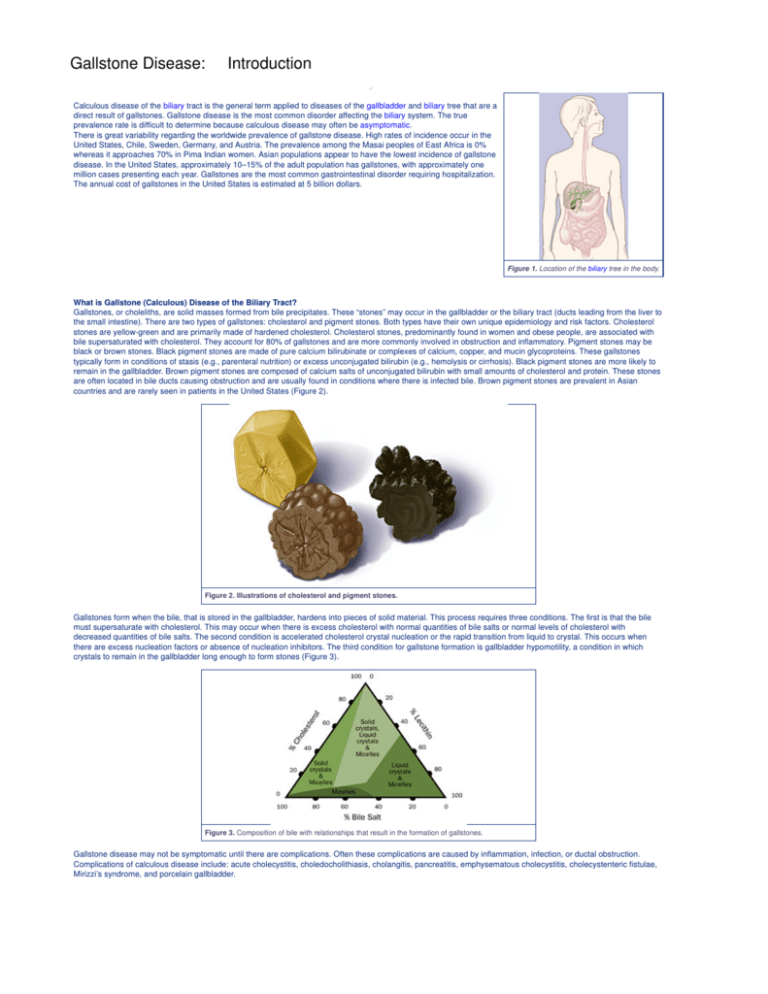
Gallstone Disease:
Introduction
Calculous disease of the biliary tract is the general term applied to diseases of the gallbladder and biliary tree that are a
direct result of gallstones. Gallstone disease is the most common disorder affecting the biliary system. The true
prevalence rate is difficult to determine because calculous disease may often be asymptomatic.
There is great variability regarding the worldwide prevalence of gallstone disease. High rates of incidence occur in the
United States, Chile, Sweden, Germany, and Austria. The prevalence among the Masai peoples of East Africa is 0%
whereas it approaches 70% in Pima Indian women. Asian populations appear to have the lowest incidence of gallstone
disease. In the United States, approximately 10–15% of the adult population has gallstones, with approximately one
million cases presenting each year. Gallstones are the most common gastrointestinal disorder requiring hospitalization.
The annual cost of gallstones in the United States is estimated at 5 billion dollars.
Figure 1. Location of the biliary tree in the body.
What is Gallstone (Calculous) Disease of the Biliary Tract?
Gallstones, or choleliths, are solid masses formed from bile precipitates. These “stones” may occur in the gallbladder or the biliary tract (ducts leading from the liver to
the small intestine). There are two types of gallstones: cholesterol and pigment stones. Both types have their own unique epidemiology and risk factors. Cholesterol
stones are yellow-green and are primarily made of hardened cholesterol. Cholesterol stones, predominantly found in women and obese people, are associated with
bile supersaturated with cholesterol. They account for 80% of gallstones and are more commonly involved in obstruction and inflammatory. Pigment stones may be
black or brown stones. Black pigment stones are made of pure calcium bilirubinate or complexes of calcium, copper, and mucin glycoproteins. These gallstones
typically form in conditions of stasis (e.g., parenteral nutrition) or excess unconjugated bilirubin (e.g., hemolysis or cirrhosis). Black pigment stones are more likely to
remain in the gallbladder. Brown pigment stones are composed of calcium salts of unconjugated bilirubin with small amounts of cholesterol and protein. These stones
are often located in bile ducts causing obstruction and are usually found in conditions where there is infected bile. Brown pigment stones are prevalent in Asian
countries and are rarely seen in patients in the United States (Figure 2).
Figure 2. Illustrations of cholesterol and pigment stones.
Gallstones form when the bile, that is stored in the gallbladder, hardens into pieces of solid material. This process requires three conditions. The first is that the bile
must supersaturate with cholesterol. This may occur when there is excess cholesterol with normal quantities of bile salts or normal levels of cholesterol with
decreased quantities of bile salts. The second condition is accelerated cholesterol crystal nucleation or the rapid transition from liquid to crystal. This occurs when
there are excess nucleation factors or absence of nucleation inhibitors. The third condition for gallstone formation is gallbladder hypomotility, a condition in which
crystals to remain in the gallbladder long enough to form stones (Figure 3).
Figure 3. Composition of bile with relationships that result in the formation of gallstones.
Gallstone disease may not be symptomatic until there are complications. Often these complications are caused by inflammation, infection, or ductal obstruction.
Complications of calculous disease include: acute cholecystitis, choledocholithiasis, cholangitis, pancreatitis, emphysematous cholecystitis, cholecystenteric fistulae,
Mirizzi’s syndrome, and porcelain gallbladder.
Symptoms and Clinical Features
Most people with gallstones do not have symptoms, however those who do have symptoms are much more likely to develop complications.
Seventy to 80% of symptomatic patients complain of biliary colic. Biliary colic is a visceral pain, thought to be caused by functional spasm, resulting from transient
obstruction of the cystic duct by a stone. The pain is characterized as episodic and severe epigastric pain; less commonly, it is located in the right upper quadrant, left
upper quadrant, precordium, or lower abdomen. The pain generally has a sudden onset, rising in intensity, and lasting from 15 minutes to several hours. Pain may be
accompanied by radiation to the interscapular region or the right shoulder often with vomiting and diaphoresis. Biliary colic may also present with symptoms of
nonspecific dyspepsia such as intolerance of fatty foods, pyrosis, flatulence, aerophagia sweating, yellowish color of skin or sclera of the eye, and clay-colored stools
are symptoms that suggest complications such as cholangitis and choledocholithiasis and warrant immediate medical attention. The interval between “attacks” is
unpredictable and may range from days to months or years.
© Copyright 2001-2013 | All Rights Reserved.
600 North Wolfe Street, Baltimore, Maryland 21287
Gallstone Disease:
Anatomy
The gallbladder is located under the surface of the liver, bound by vessels, connective tissue, and lymphatics. It has four regions: the fundus, body, infundibulum, and
the neck. The gallbladder terminates in the cystic duct and then enters the extrahepatic biliary tree. The fundus is the round, blind edge of the organ. It is composed of
fibrotic tissue and projects just beyond the right lobe of the liver. The fundus leads to the body of the gallbladder, the largest part. The superior surface of the body is
attached to the visceral surface of the liver, unless a mesentery is present. This close relationship allows for the direct spread of inflammation, infection, or neoplasia
into the liver parenchyma. The infundibulum is the tapering area of the gallbladder between the body and neck. This portion and the free surface of the body of the
gallbladder lies close to the first and second portions of the duodenum, and in close proximity to the hepatic flexure and right third of the transverse colon. The
infundibulum is attached to the right transverse colon surface of the second part of the duodenum by the cholecystoduodenal ligament. The neck of the gallbladder is
5–7 mm in diameter and often forms an S-shaped curve. It is superior and to the left, narrowing into a constriction at the junction with the cystic duct (Figure 4).
Figure 4. Normal anatomy of the biliary system
The right and left hepatic ducts unite in an extrahepatic position in most cases. The length of the hepatic lobar duct varies from 0.5–1.5 cm. Usually, a short
extrahepatic right lobar duct joins a longer left duct at the base of the right branch of the portal vein at differing angles. The common hepatic duct is formed by the
merger of right and left hepatic ducts. In a minority of cases, a right segmental duct joining a left hepatic duct forms a third duct. There may be numerous variations in
the left ductal system (Figure 5).
Figure 5. Variations in the anatomy of the cystic duct
Twenty percent of the population has accessory hepatic ducts. In these individuals, the aberrant duct joins the common hepatic duct at various locations along its
course. In rare instances this aberrant duct may join the cystic duct or a duct in the opposite lobe. Usually, however, these aberrant ducts are on the right side (Figure
6).
Figure 6. Variations in the anatomy of the gallbladder and biliary tree.
The hepatocyte-cholangiocyte level is the beginning of the biliary drainage system and where portions of the hepatocyte membrane form the canaliculi (small
channels). Bile drains from this level into intrahepatic ducts. The canaliculi and proximal ductal system converge in the canal of Hering. Smaller ducts combine to form
the segmental bile duct. Segmental ducts within the liver form the right and left hepatic ducts. Union of ducts from hepatic segments II, III, and IV form the left lobar
duct. The right hepatic duct drains segments V, VI, VII, and VIII.
Lining the intrahepatic ducts are cholangiocytes (epithelial cells). The cholangiocytes line complex networks of interconnecting tubes involved in secretory and
absorptive processes. Cholangiocytes may be cuboidal in smaller ductal structures. They are columnar in larger structures and contain microvilli increasing surface
area. These cells are believed to play a role in transport functions (protein from lymph or plasma into the bile). It is also probable that they are involved in the transport
and metabolism of bile acids. Actually, it is likely these cells are hormone responsive.
The hepatic artery arises from the celiac axis and courses through the upper portion of the pancreas toward the liver. The hepatic artery gives rise to the
gastroduodenal artery posterior and superior to the duodenum. It divides to right and left branches and then into smaller branches. In many cases, a third artery
supplies portions of segment IV and the right lobe of the liver.
The right, middle, and left hepatic veins drain most of the hepatic flow and empty into the inferior vena cava. Each has a short extrahepatic segment. The largest vein,
the right hepatic, drains the right lobe of the liver. The middle vein drains the medial segment of the left lobe and some of the anterior segment of the right. The middle
hepatic vein joins the left hepatic vein with variability in the juncture site. The left hepatic vein drains the left lateral segment of the liver.
The portal venous system extends from the intestinal capillaries to the hepatic sinusoids (Figure 7). This venous system carries the blood from the abdominal
gastrointestinal tract, the pancreas, gallbladder, and spleen back to the heart (coursing through the liver). The largest vessel in this system is the portal vein, which is
formed by the union of the splenic vein and superior mesenteric veins. The left gastric and right gastric veins and the posterior superior pancreaticoduodenal vein
drain directly into the portal vein. The portal vein runs posterior to the pancreas, and its extrahepatic length may be anywhere from 5–9 cm. At the porta hepatis, it
divides into the right and left portal veins within the liver, and the cystic vein typically drains into the right hepatic branch.
The portal vein supplies 70% of the blood flow to the liver, but only 40% of the liver oxygen supply. The remainder of the blood comes from the hepatic artery, and
blood from both of these vessels mixes in the sinusoids.
Figure 7. Anatomy of the portal venous system.
Gallstone Disease:
Causes
Age
The incidence of gallstone disease increases with age. Symptomatic calculous disease of the biliary tract is rare before the age of 20, and when found in this group,
is commonly among patients with chronic predisposing conditions such as cystic fibrosis or hemolytic anemia.
Drugs
Many drugs have been implicated in gallstone disease. The most common offenders include ceftriaxone, clofibrate, oral contraceptives, estrogen replacement,
progestogens, and octreotide. Some drugs are secreted into bile and may complex, precipitate, and form stones. Other compounds can produce gallbladder stasis
with concomitant increases in cholesterol secretion into bile.
Gender
The prevalence of gallstones is higher in women than men. Studies have shown that gallstone disease is common in young women but rare in young men. However,
the difference narrows with increasing age. It is presumed that the reason for this gender difference is hormonal. Serum estrogen increases (especially during
pregnancy) promotes biliary cholesterol saturation and increased progesterone may lead to inhibition of the contraction of the gallbladder.
Geography and Ethnicity
The Pima Indians of Arizona have the highest prevalence of gallstones worldwide. Ninety percent of Pima women over the age of 65 have gallstone disease. The
Micmac Indians of Canada, Hispanics, and Mexican American women also have a higher prevalence of gallstone disease, as do both men and women in Norway and
Chile. The risk appears to be lower in blacks. No genes have been identified in humans that are conclusively linked to gallstone development.
Obesity
Obesity is a significant risk factor for gallstone disease, especially in women. Studies have demonstrated that overweight women with a body mass index (BMI)
greater than or equal to 30 kg/m2 have double the risk of gallstone disease when compared with normal weight women with less than 25 kg/m2. Cholesterol
hypersecretion(associated with obesity) is a major pathogenic factor. Gallstone disease has also been associated with the regional distribution of fat. High central or
truncal adiposity has been positively correlated with risk of gallstone disease. Physical activity and diet have been studied independently as risk factors for gallstone
disease. Increased vigorous physical activity and recreational activity appear to reduce gallstone disease risk.
Weight Loss
An increased risk of gallstone disease may be found among individuals who undergo rapid weight loss on very low calorie diets. Gallstone formation is one of the
most significant complications of voluntary weight loss plans. In these instances, cholesterol is activated from adipose tissue and secreted into the bile. This leads to
cholesterol supersaturation and diminishes gallbladder contraction, producing stasis. Studies have shown that individuals on weight loss plans, either dramatically
reduced calorie diets or surgical weight-loss procedures, have a higher incidence of development of gallstone disease when compared to those who are not dieting.
Weight fluctuation may also be a risk factor.
© Copyright 2001-2013 | All Rights Reserved.
600 North Wolfe Street, Baltimore, Maryland 21287
Gallstone Disease:
Diagnosis
Overview
The physical exam in patients with gallstone-related symptoms can often be completely normal. However, sometimes a gallbladder can be palpated and there may be
right subcostal tenderness with inspiratory arrest (Murphy's sign), which is suggestive of acute cholecystitis.
Laboratory Tests
Biochemical tests of liver function are abnormal only when there are complications of gallstones. In acute cholecystitis, there may be leukocytosis with a "left" shift.
Gallstones cause acute pancreatitis with concomitant elevations in the amylase and lipase levels. Gallstones causing obstruction of the common bile duct will result in
elevations of hepatic transaminases and alkaline phosphatase.
Radiological Studies
Most gallstones, especially those that are asymptomatic, are incidentally discovered when patients are undergoing imaging for other problems. In situations where the
index of suspicion for uncomplicated gallstones is high based on a patient’s history and physical exam, there are noninvasive and invasive procedures available.
These procedures are used to determine the presence or absence of gallstones as well as their location in the gallbladder and/or biliary tree.
Ultrasonography
The best noninvasive test for detecting gallstones in the gallbladder is abdominal ultrasonography because of its high specificity and sensitivity (90–95%) (Figure 8).
Ultrasonography is a procedure in which sound waves are used to create images of organs. It is a simple procedure, requires no special preparation, does not employ
ionizing radiation, and provides accurate anatomical information. Intramural gas and pericholecystic fluid collection indicate active gallbladder inflammation or
infection. Ultrasound may also indicate distal obstruction by the finding of dilated intrahepatic or extrahepatic bile ducts. This test is less useful for excluding gallstones
obstructing the common bile duct.
Figure 8. Ultrasonography of gallstones; A, ultrasound probe postioning; B, gallstone-filled gallbladder;
C. ultrasound image showing gallstones.
CT Scan
Detection of calculous disease may employ computed tomography (CT) scanning. CT scans are useful in demonstrating masses and dilated biliary ducts, although
they are not as reliable for the diagnosis of calculous disease. Their principle use is detection of the complications of gallstones such as pericholecystic fluid, gas in
the gallbladder wall, gallbladder perforations, and abscesses. These noninvasive tests may help determine which patients will require urgent surgical intervention
(Figure 9).
Figure 9. CT image of gallstones; A, CT section of gallbladder filled with stones; B, CT image showing
gallstones.
MRI and MRCP
Magnetic resonance cholangiopancreatography (MRCP) is a relatively new application that utilizes MRI imaging with special software. It is capable of producing
images similar to ERCP without the accompanying risks of sedation, pancreatitis, or perforation. MRCP is helpful in assessing biliary obstruction and pancreatic
ductal anatomy. It has been shown to be effective in detecting gallstones and to evaluate the gallbladder for the presence of cholecystitis. Currently, the major
shortcoming of MRCP lies in the experience of the interpreting physician. Additionally, the procedure does not allow therapeutic interventions like ERCP.
Oral Cholecystography
Oral cholecystography is another noninvasive test, although it is infrequently performed. In preparation for this procedure, the patient must ingest a dose of an oral
contrast agent on the evening before the test. This contrast is absorbed and secreted into the bile. The iodine in the contrast produces opacification of the gallbladder
lumen on a plain radiograph the next day. Gallstones appear as filling defects. The main use of oral cholecystography is to establish patency of the cystic duct. This
information is required before attempting lithotripsy or medical methods to dissolve gallstones. A major drawback of oral cholecystography is that it takes 48 hours to
perform, which limits its usefulness in patients with acute cholecystitis and gallstone complications.
Cholescintigraphy
Cholescintigraphy employs the use of an intravenous radioactive iminodiacetic acid derivative. This labeled derivative is rapidly absorbed by the liver and excreted
into the bile. Serial scans demonstrate the radioactivity in the gallbladder, common bile duct, and small bowel within 30–60 minutes. A nonfunctioning gallbladder is
diagnostic of acute cholecystitis (Figure 10). Cholescintigraphy may be useful in determining whether empiric cholecystectomy will benefit a patient with chronic biliary
pain without gallstones. Prolonged fasting and acute cholecystitis can result in false-positive results.
Figure 10. Cholescintigraphy
Endoscopic Diagnosis
Endoscopic Retrograde Cholangiopancreatography (ERCP)
ERCP is the gold standard for the detection of gallstones in the common bile duct and has the advantage of being the therapeutic modality of choice for removing bile
duct stones.
Figure 11. Position of endoscope facing major papilla for ERCP.
ERCP is an endoscopic technique for visualization of the bile and pancreatic ducts. During this procedure, the physician places a side-viewing endoscope
(duodenoscope) in the duodenum facing the major papilla (Figure 11). The duodenoscope is specially designed to facilitate placement of endoscopic accessories into
the bile and pancreatic duct. The endoscopic accessories may be passed through the biopsy channel into the bile and pancreatic ducts (Figure 12). A catheter is used
to inject dye into both pancreatic and biliary ducts to obtain x-ray images using fluoroscopy. During this procedure, the physician is able to see two sets of images, the
endoscopic image of the duodenum and major papilla, and the fluoroscopic image of the biliary and pancreatic ducts.
Figure 12. Room set-up and patient positioning for ERCP
The scope is designed to be held in the left hand with the thumb operating up and down angulation. The index finger operates the suction and air/water operations.
The right hand is responsible for advancing, withdrawing and torquing the insertion tube. The right hand also operates left and right angulation of the scope and
passes accessories through the instrument.
Figure 13. Side-viewing endoscope (duodenoscope) used for ERCP.
A variety of instruments can be utilized through the duodenoscope (Figure 13) such as catheters, sphincterotomes, wire baskets, brushes, biopsy forceps, dilation
balloons, and stents. Lithotripsy devices, for both mechanical and electrohydraulic lithotripsy, may be inserted through the scope. These devices are used when
stones are large and need to be broken into smaller pieces to facilitate removal or when the end of the bile duct is too narrow to allow easy stone removal. Pictures
may be taken for photo documentation. Video cameras may also be attached for full-color motion picture viewing during endoscopic procedures, or for later review.
Endoscopic Ultrasonography
Endoscopic ultrasonography (EUS) is a highly technical, low-risk diagnostic procedure that utilizes high-frequency ultrasound during endoscopy to evaluate and
diagnose digestive tract disorders. EUS allows imaging of the common bile duct and the gallbladder. EUS employs a duodenoscope with a distal ultrasound probe
that can be used to image organs, blood vessels, lymph nodes, and bile ducts. The EUS scope is advanced within the gastrointestinal tract. From a position in the
stomach or duodenum, the endoscope allows visualization of the pancreas and adjacent structures (Figure 14).
EUS can accurately diagnose the presence or absence of gallstones in the common bile duct but lacks the therapeutic usefulness of ERCP. EUS is more likely to be
used when the pretest probability of finding gallstones is low, particularly in high-risk patients. EUS is preferable in this situation because it lacks the potential
complications of ERCP.
Figure 14. A, Endoscopic ultrasonography demonstrating a common bile duct stone. B, Relationship of
endoscopic ultrasonography transducer and ultrasonography beam to the common bile duct.
© Copyright 2001-2013 | All Rights Reserved.
600 North Wolfe Street, Baltimore, Maryland 21287
Gallstone Disease:
Therapy
Overview
There are a number of treatment options for patients with symptomatic gallstones. Each treatment option has different outcomes for patients presenting with different
clinical characteristics. Symptomatic patients should be treated to relieve their symptoms and prevent the development of complications in the future. There is no
benefit to prophylactic treated; asymptomatic patients should be managed expectantly .
Medical Therapy
Several medical treatment options are available for symptomatic gallstones. Oral dissolution therapy involves a number of agents that interfere with the development
of gallstones in the gallbladder. Ursodeoxycholic acid and HMG CoA reductase inhibitors both suppress de-novo hepatic cholesterol synthesis. This results in the
secretion of under saturated bile, facilitating stone dissolution. Careful patient selection is the major determinant of outcome. These agents are only useful in those
with small, noncalcified cholesterol stones who have a functional gallbladder. Only 15% of patients qualify, therapy takes at least 6–12 months, and gallstones recur in
50% of patients within 5 years.
Surgical Therapy
Cholecystectomy is the only definitive treatment for symptomatic gallstones. Each year, approximately 500,000 Americans have a cholecystectomy. While open
cholecystectomy was the standard surgical option for patients in the past, laparoscopic cholecystectomy has replaced the open procedure as the treatment option of
choice in all but a few instances. Laparoscopic cholecystectomy is a minimally invasive procedure in which the surgeon makes a few small incisions in the abdomen
and uses a small video camera to magnify the organs of the abdominal cavity. Using the video monitor to guide his actions, the surgeon identifies, isolates, and
removes the gallbladder from its connections to the liver and bile ducts through the laparoscope (Figure 15). The procedure does not involve a large abdominal
incision and results in less pain, shorter hospital stay, and fewer days missed from work. On occasion, the surgeon may begin a procedure using the laparoscopic
approach and then may have to convert to an open procedure because of the presence of scarring, infection, or variant biliary anatomy. Reported conversion rates
are around 5% and are more common with emergent procedures.The most common complication in either procedure is injury to the bile duct. (These can often be
treated effectively by ERCP and stent placement across the papilla to enable healing of the injured bile duct site.)
Figure 15. A, B, Technique of cholecystectomy; A’, B’, laparoscopic views during and after the
procedure.
Extracorpeal Shock Wave Lithotripsy
Extracorpeal shock wave lithotripsy (ESWL) is a nonsurgical alternative to manage gallstones. No general anesthesia is required and the patient may be managed on
an outpatient basis. This method employs high-energy sound waves that produce shock waves. These shock waves are transmitted through water and tissue and
have the ability to generate compressive and tensile waves. Disintegration and fragmentation of the gallstones occurs by producing forces strong enough to fracture
the stones.
ESWL may be an option for those patients who: are poor surgical candidates with a functioning gallbladder, have patent cystic duct, have noncalcified cholesterol
stones between 4–30 mm in diameter, and have three or less stones. Pregnancy, cholecystitis, cholangitis, common bile duct obstruction, pancreatitis, and
coagulopathy are contraindications for ESWL. Due to stringent selection criteria, less than 15% of patients with calculous disease of the biliary tract will be suitable
candidates for extracorporeal shock wave lithotripsy. The side effects of this procedure include abdominal wall and skin changes (ecchymosis, petechiae), pain,
hematuria, nausea, emesis, and biliary colic. Fragmentation of large stones by a fluoroscopically guided mechanical lithotripsy device can be achieved in most cases,
and complete ductal clearance is frequently successful. Because laparoscopic cholecystectomy has widespread acceptance and may also be performed on an
outpatient basis, extracorporeal shock wave lithotripsy has not gained great popularity.
Percutaneous Therapy
In high-risk patients with acute calculous diseases, surgical intervention may be associated with increased morbidity and mortality. The percutaneous approach to
therapy may be less invasive than surgical removal of the gallbladder. The gallbladder may be accessed percutaneously and any gallstones may be removed or
fragmented. Percutaneous approaches to the gallbladder involve two routes: transperitoneal and transhepatic. Studies have demonstrated that the transperitoneal
approach to the gallbladder is more difficult because of interposing right colon or liver, and consequently, it is employed in less than 20% of patients. The transhepatic
approach is used about 80% of the time because of its ease and safety. Percutaneous cholecystolithotomy involves puncturing the gallbladder, dilating the tract, and
removing any gallstones with a cholecystoscope. The advantages of this procedure are the immediate removal of uncrushed gallstones, the production of little
gallstone debris, and the reduction of danger associated with sludge entering the cystic duct. Percutaneous cholecystolithotripsy refers to the disintegration of
gallstones too large to remove using one of three devices: ultrasonic lithotriptor, electrohydraulic lithotriptor, and YAG laser.
Contact dissolution therapy may be performed percutaneously by injecting a solvent directly into the gallbladder via a catheter. Monooctanoin was shown to have high
in vitro activity in dissolving cholesterol stones but is less efficient in vivo. Dissolution takes 1–3 weeks and the results are not always consistent. Methyl tert-butyl
ether can clear cholesterol stones in hours to days but it is a toxic, inflammable anesthetic with considerable side effects and is still an experimental procedure used in
specialized centers. The recurrence rate of gallstones is unknown with either solvent. Both solvents may continue to have some role in the care of patients with
symptomatic gallstones who are poor surgical candidates.
Endoscopic Gallbladder Stenting
Endoscopic gallbladder stenting is another nonsurgical approach to treatment of gallstones that may be useful in high-risk patients. This procedure uses endoscopic
retrograde cholangiopancreatography (ERCP) to insert a stent from the gallbladder to the duodenum to relieve biliary symptoms and complications in high-risk
patients. A hydrophilic wire is passed from the ampulla of Vater into the common bile duct and into the gallbladder through the cystic duct. A nasobiliary pigtail
catheter, or double-pigtailed stent, is advanced over the hydrophilic wire into the gallbladder. This procedure has been successful in high-risk patients. It is less
invasive than cholecystectomy and patients may be discharged quickly. Additionally, unlike other procedures that leave the gallbladder intact, further stone formation
does not hinder the effectiveness of endoscopic stenting.
Acute Cholecystitis
The most common complication of gallstones is acute cholecystitis. Acute cholecystitis is usually caused by impaction of a gallstone in the cystic duct. The entrapped
bile in the gallbladder causes damage to the gallbladder mucosa and inflammation of the gallbladder wall. The hallmark clinical presentation is abdominal pain, right
upper quadrant tenderness, fever (usually <102°F), and modest leukocytosis (<16,000). Optimal management of a patient with cholecystitis is cholecystectomy.
Suspected acute cholecystitis is confirmed by a right upper quadrant ultrasonography and cholescintigraphy.
Choledocholithiasis
Choledocholithiasis may be diagnosed and treated with endoscopic or percutaneous cholangiography. It is a complication that occurs when gallstones become
displaced to the common bile duct. Whereas gallstones in the gallbladder usually result in relatively benign conditions such as recurrent biliary colic or acute
cholecystitis, choledocholithiasis can result in life-threatening conditions such as cholangitis (bacterial infection of obstructed bile) or acute pancreatitis.
Choledocholithiasis is caused by the migration of cholesterol or black pigment stones from the gallbladder into the common bile duct. Symptoms are related to the
rate of onset and degree of obstruction and the potential bacterial contamination of the obstructed bile. The condition can often be asymptomatic but, if present, is the
same as biliary colic. Physical findings are often not present if the obstruction is intermittent; however, if obstruction ensues, there can be jaundice. If the jaundice is
associated with pain, then stones are the likely cause. Laboratory studies demonstrate an elevation in bilirubin and alkaline phosphatase if the obstruction lies in the
common bile duct, whereas elevations in pancreatic lipase and amylase occur if the gallstone causes pancreatic ductal obstruction. The gold standard for the
diagnosis and treatment of gallstones obstructing the common bile duct and/or pancreatic main duct is ERCP.
If cholangitis develops, pain, jaundice, fever, mental confusion, lethargy and delirium may all be present. Leukocytosis, elevations in bilirubin and alkaline
phosphatase, and positive blood cultures are also present. Therapy with intravenous antibiotics and removal of obstructing stone(s) by ERCP is indicated.
Pancreatitis may occur if stones obstruct the common channel of bile. Pancreatic ducts may be treated by removal of the obstructing stone by ERCP. If ERCP is
unsuccessful or unavailable, common bile duct stones may be removed by the percutaneous method (Figure 23, 24) using the same accessories used in the
endoscopic method.
Figure 23. Percutaneous removal of common bile duct stones using: A, balloon dilation catheter; B,
balloon extraction catheter.
Figure 24. Percutaneous removal of common bile duct stones using: A, lithotripsy catheter; B, balloon
extraction catheter
]
Less Common Complications
There are other less common complications of calculous disease of the biliary tract. Emphysematous cholecystitis occurs when the gallbladder wall is secondarily
infected with gas-forming bacterial microbes. The condition is more likely to occur in the elderly and diabetic men, often occurring without stones. The clinical
presentation is similar to acute cholecystitis but more toxic. A plain radiograph will show gas in the gallbladder fossa, which can be confirmed with ultrasonography or
CT scan. Treatment requires antibiotics with anaerobic coverage and early cholecystectomy.
Cholecystenteric Fistulae
Cholecystenteric fistulae form when a large stone erodes through the gallbladder wall into an adjacent loop of bowel. If the stone is very large (>25 mm), it may
produce a small bowel obstruction, known as gallstone ileus, found commonly in the terminal ileum. Diagnosis involves a plain radiograph, an x-ray capable of
demonstrating air in the biliary tree and possible obstruction of the small bowel in the case of gallstone ileus. Treatment involves cholecystectomy and bowel
resection.
Mirizzi's Syndrome
Mirizzi's syndrome is the result of a gallstone obstructing the cystic duct and resulting in inflammation and compression of the common bile duct (Figure 25). The
symptoms and signs involve jaundice and pain. The diagnosis and treatment involve ERCP .
Figure 25. Mirizzi’s syndrome.
Porcelain Gallbladder
A porcelain gallbladder is a rare complication in which there is intramural calcification of the gallbladder wall, usually in association with gallstones. The most serious
late complication of this condition is gallbladder carcinoma. The treatment involves prophylactic cholecystectomy .
Figure 26. Porcelain gallbladder
© Copyright 2001-2013 | All Rights Reserved.
600 North Wolfe Street, Baltimore, Maryland 21287

